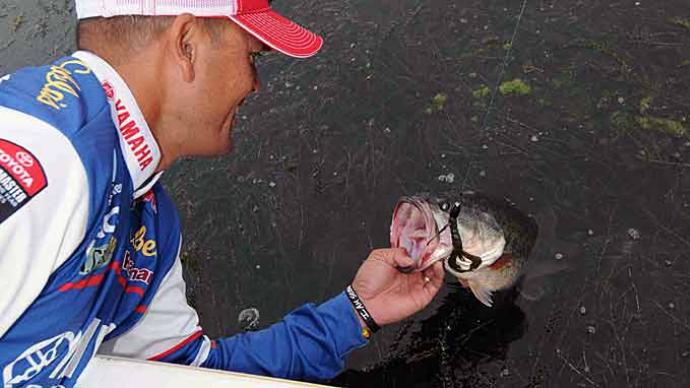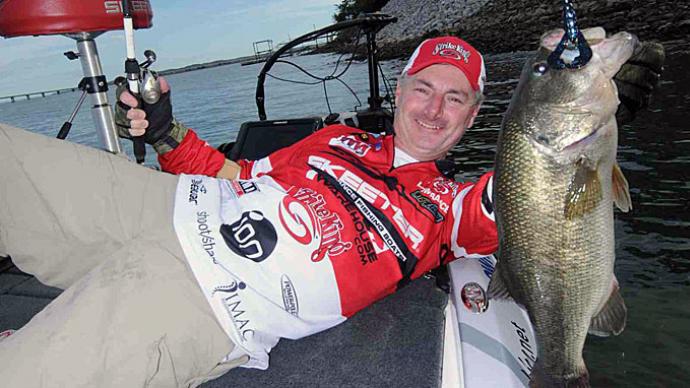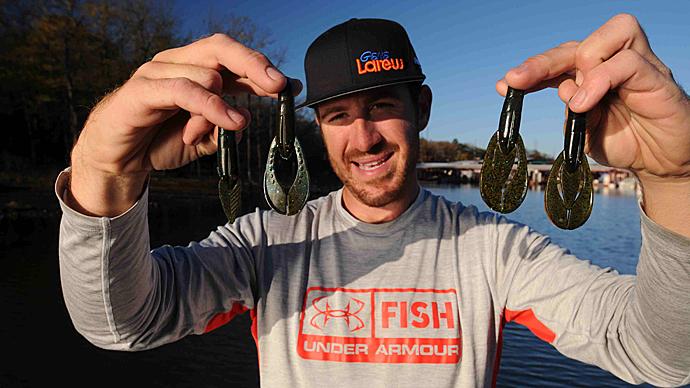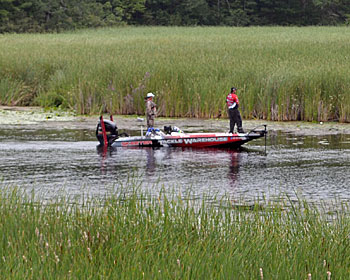
Bass fishing has become a precise game. Gone — for the most part — are the days of working down a bank, winging a lure, and hoping to come across something with fins. Today’s electronics, for example, put anglers on top of small offshore bass-holding spots again and again. Closer to shore, anglers pluck bass from individual pieces of cover on small structural elements. That makes being proficient at flipping and pitching important. Few other techniques put lures in as precise spots in heavy cover.
Flipping involves drawing a line from in front of the reel with one hand while the other dips the rod’s tip and, with an upward sweep, pendulums the lure forward as the line is released. It’s perfect for dissecting heavy cover a few feet from the boat. Pitching extends your reach. Holding the bait in one hand, a twist of the wrist rolls the rod tip forward and sends the lure on a gentle float until your thumb stops the spool, resulting in a soft splashdown next to — or inside — the intended target.
While those are the basic mechanics, there’s more to flipping and pitching. Fine-tune your technique, lure choices, and presentations; you can make these two bass-catching presentations even more productive. Here are ten ways to do just that.
- Use heavier lures
Lure weight is often thought of in relation to lure size — heavier ones are larger — or bass activity — a lighter one will draw strikes from wary bass swimming in clear water. But heavier lures can make your flips and pitches more accurate.
As a general rule, use the heaviest lure you can. Going from a 3/8-ounce to a ½-ounce jig won’t add much bulk to your bait, but it will add accuracy to your pitches and flips. The additional weight will load your rod more and follow a straighter trajectory. If you are fishing overhanging trees, it will push through branches to reach hidden spots. The same principle goes for bullet weights on your Texas rigs.
If you’re worried that that extra weight will cause your lure to sink too quickly for wary bass, slow its fall by using a slightly larger soft-plastic lure or bulkier jig trailer. A thicker skirt will slow a jig’s fall, too.
- Use braided line
The line is an essential part of your flipping and pitching gear. You want one stout enough to extract big bass from heavy cover yet subtle enough to flow freely from the reel, allowing your lure to go farther. Braided line has both traits.
As the pound test of monofilament and fluorocarbon lines increases, so does the diameter. That means they usually are stiffer, developing more memory and not easily moving through your rod’s guides. That works against you when making soft underhand flips and pitches.
Braided line has none of those issues. It’s available in pound tests that you’ll never break at diameters equivalent to monofilament lines a fraction of its strength. Braided line rated at 65-pound test, for example, is about the diameter of 15-pound test monofilament. You can forget about memory with braid. It’s highly abrasion-resistant, too.
Braid has one downfall, which may be only in our minds. It’s more visible underwater than either fluorocarbon or monofilament. How much that influences a bass is debated. Aquatic vegetation stems can camouflage it. If you’re worried about its visibility around brush, wood, or docks, you can do a couple of things. Use a black or dark green permanent marker to color 3 or 4 feet of line directly above your lure, either entirely or in sections. You also can use an 18- to 24-inch monofilament or fluorocarbon leader. Attach it to your braid with a double uni or Alberto knot.
- Use a slower-action rod
Flipping rods have always been seen as bass fishing’s equivalent of a pool cue. They’re supposed to be stiff from tip to handle. That’s great for pulling a hooked bass from heavy cover, but it’s not the best for accurately flipping or pitching a lure to where it needs to go.
Proper loading the rod's blank is the key to getting the most distance and accuracy on a pitch or flip. When you move the rod back, you want the lure’s weight to pull on the top quarter or third of the rod and then use that stored energy on the forward swing to help launch it. You’ll find that in some heavy-action rods and most medium-heavy actions.
There’s an easy way to find a rod with this action. Gently set the rod tip on the floor and apply downward pressure on the handle.
- High-speed reels are important
Pitching and flipping are some of the best techniques for fast fishing slowly. That’s a contradiction of terms, but it makes sense when bass are spread out and want a slow presentation. To make it work, you must make up time, so your lure can spend more of it in the water. A faster reel is the easiest way to do that.
If you switch from a 6:1 to a 7:1 gear ratio, you’ll retrieve more line faster, cutting the time you spend cranking after each flip or pitch. Do this with the faster reel all day, and you’ll tally more presentations. To help keep your reel speedy, ensure the spool is full of line. That gives it a larger diameter, meaning more lines is picked up per revolution.
Fast reels offer one more benefit. Sometimes bass will grab your flipped or pitched lure the instant it hits the water. When one does, just a half spin of the handle will engage the reel and draw your line tight so that you can hammer the hook home.
- Try to use one hand
One more way to be ready for quick strikes: If you’re right-handed, learn to cast with your left hand or switch to left-handed reels. Both will take some practice to master. But when you do, you won’t be moving the rod from one hand to the other after each pitch or flip.
If you consider yourself too much of an old dog to learn that new trick, there is a second option. Keep your hands close together and switch while the lure is still in the air. You’ll have to thumb the spool with your left hand, but it will save time.
- Fish deeper
Image
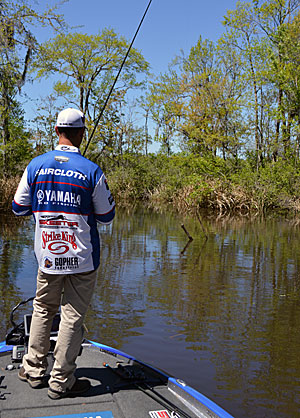
Shallow-water cover along the bank is a prime place to flip and pitch, but both techniques can be used in deeper water offshore. Photo by Pete M. Anderson Flipping and pitching are full-contact techniques, so don’t only poke around the edges of heavy cover. Crash your lure through matted vegetation. Make that pitch to the middle of a bush or branches on a laydown. Chances are that’s where the biggest bass is holding.
In emergent vegetation, for example, look for “alleys,” where you can pitch your bait deeper inside. You also can go topside. There will often be open water way back in the beds, but you might not be able to see it from the outside. So pitch your lure up and over the vegetation.
Deeper doesn’t always mean farther into the heavy cover along the bank. You can flip and pitch offshore, too, as long as there is cover to fish. Take the recent Bassmaster Elite Series event on Cayuga Lake in New York’s Finger Lakes region. Many competitors flipped and pitched drop shots, jigs, and weightless soft-plastic lures into aquatic vegetation beds. That approach helps keep your lure in the high percentage spots, such as the points, edge, or holes.
You can even flip and pitch to flooded standing timber. Bass suspended in the tops. All you need to do is get your lure into the cover, and down to the depth they’re holding.
- Learn to skip
There’s no better way to put your lure under a dock, pontoon boat, or boathouse door than to skip it. Skipping is a variation of pitching. You’ll want to put more speed on your lure and keep its trajectory closer to the water’s surface. You want it to skitter along like a stone.
It will take practice and some backlashes to master skipping. Lures with large surface areas, such as a plastic chunk threaded onto a jig hook, will help. But once you get the hang of it, you’ll skip your lures under all sorts of cover.
- Peg your weight
It’s challenging to make a successful flip or pitch if your weight ends up in one spot and your soft-plastic lure elsewhere. But that’s precisely what will happen if you use a free-sliding bullet sinker. Pegging the weight will solve that problem. There are two ways to do that.
The first involves bullet weights with a spiral-shaped wire protruding from the wider end. Once on your line, push the weight against the lure, and spin it. The wire will bite into the plastic, pulling the weight against it and holding it in place.
The second option uses a small robber stop, similar to what is used with slip bobbers. Those stops work well for this, too. The stops usually come on a folded piece of wire. Run your line through the wire loop, and work the stop onto your line. Once there, slide on your sinker, tie a hook and rig a lure. Then slide the stop down the line to lock the weight in place.
You don’t have to push the stop tight against the weight. If you leave about a ½-inch of play, the sinker will move away from your lure just enough to give it more action. You can add a glass bead between the weight and the lure. The moving weight will clack with it, attracting bass.
- Try different lures
It’s easy to get caught in a lure rut when flipping and pitching. The techniques were built around Texas-rigged soft plastics and jigs. But they work well with other types, too.
Some bass anglers report success flipping spoons — jigging and flutter — into holes and against edges of heavy vegetation. A quick pitch can put a spinnerbait into laydowns, down the side of a dock, or tight against a seawall during the shad spawn. Pitch frogs into openings in emergent aquatic vegetation, under overhanging trees, such as willows, and around docks and laydowns.
Crankbaits also can be pitched. You can even “de-tune” them, slightly bending the line tie, so they favor one direction and find their way underneath docks. Just mind the hooks when you pick one up to make a pitch.
- Vary your lure sizes
Lures flipped and pitched to bass carry the element of surprise with them. But just because you‘re forcing a fish to react doesn’t mean you should ignore the lure’s size.
When the bite gets tough, or you’re fishing a river or tidal fishery, downsizing your jigs and soft plastics can mean more bites. Using lighter line, or at least smaller diameter, can have the same effect. Just take care of your hook sets to not break off any bass.


